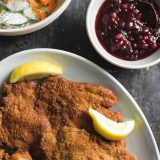Having eaten dozens of Wiener schnitzel across Frankfurt and Berlin, I thought I had a handle on this classic German and Austrian dish: a thin, juicy veal cutlet veiled in crisp breading. Except Daniel Wahnfried, the chef at Felix Austria in Berlin, was happy to prove me wrong.
For starters, he bucks tradition by favoring pork over veal, which is the officially designated meat for true Wienerschnitzel (pork variations are called either Wienerschnitzel vom Schwein, or from pork, or Schweine schnitzel). Pork, he says, is “zaftig”—richer and juicier. And he prepares the crumbs fresh, finely grinding delicate kaiser rolls to produce a crisp, not crunchy, coating.
He begins by dusting an enormous, ultrathin cutlet from a huge, marbled pork loin in seasoned flour, dunks it in egg, then finishes with a light layer of crumbs before sliding it into bubbling oil for just seconds.
There, he shakes it a bit, the move ment creating the undulating crust that defines proper Schnitzel. The goal is a crust that separates from the meat, yet won’t slide off.
For convenience, our version of this dish uses pork tenderloin rather than pork loin, as tenderloin is easier to pound thin. Though freshground kaiser crumbs are best, we found that plain breadcrumbs also work. And while most German restaurants use a neutral, highsmokepoint oil for frying Schnitzel, some use clarified butter or ghee. We found a combination of the two produced the best tasting, lightest cutlets.
The result is a juicy, lightly breaded, yet robustly meaty Schnitzel, no veal needed.




